Ha Long Bay’s values: Biodiversity Value
Ha Long Bay is located in the geographical area connected between Bai Tu Long Bay and Cat Ba Archipelago forming a sea – island complex with favorable natural conditions to form a diverse system of habitats sea and island. This is the basis for the formation of biodiversity for Ha Long Bay. Scientists have evaluated Ha Long Bay as a high biodiversity area. The biodiversity value of Ha Long Bay include the diversity of ecosystems, the diversity of rare and diverse genetic resources of species composition.
Diverse in ecosystem:
There are 10 unique types of typical ecosystems of the tropical limestone archipelago, including:
1) Flora ecosystem on the limestone island

There are 507 species (351genus of 110 families of kormobionta). Of which, 21 rare, precious and endangered species are named in the Red Book of Vietnam, and 17 plants are endemic to Ha Long Bay.
List of 21 rare and precious species on land distributed Ha Long Bay have been recorded in the Red Book:
| 1. Selaginella tamariscina | 12. Strychnos umbellata |
| 2. Drynaria bonii | 13.Stephania cepharantha |
| 3. Chroesthus lanceolata | 14.Ardisia sylvestris) |
| 4.Alangium tonkinense | 15.Meliantha suavis |
| 5. Aristolochia indica | 16.Murraya glabra |
| 6.Asarum glabrum | 17.Sinoradlkofera minor |
| 7.Sarcostemma acidum | 18.Madhuca pasquieri |
| 8.Gymnostemma pentaphyllum | 19.Paris polyphylla |
| 9. Sophora tonkinense | 20.Dioscorea collettii |
| 10. Strychnos cathayensis | 21.Stemona saxorum |
| 11. Strychnos ignatii |
17 endemic species to Ha Long Bay.
| 1. | Chirita halongensis | 10. | Cycas trophophylla | |
| 2. | Chirita hiepii | 11. | Neolitsea alongensis | |
| 3. | Chirita gemella | 12. | Ardisia pedalis | |
| 4. | Chirita modesta | 13. | Hedyotis lecomtei | |
| 5. | Impatiens halongensis | 14. | Allophylus leviscens | |
| 6. | Paraboea halongensis | 15. | Jasminum alongensis | |
| 7. | Livistona halongensis | 16. | Schefflera alongensis | |
| 8. | Alpinia calcicola | 17. | Ficus alongensis | |
| 9. | Pilea alongensis | |||
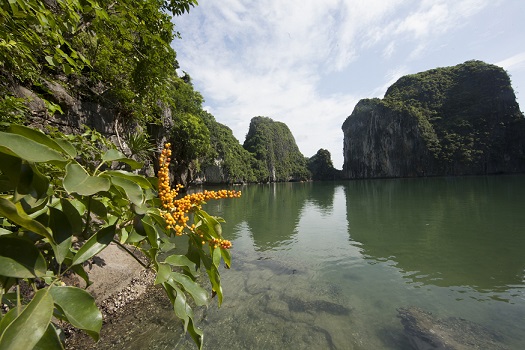 |
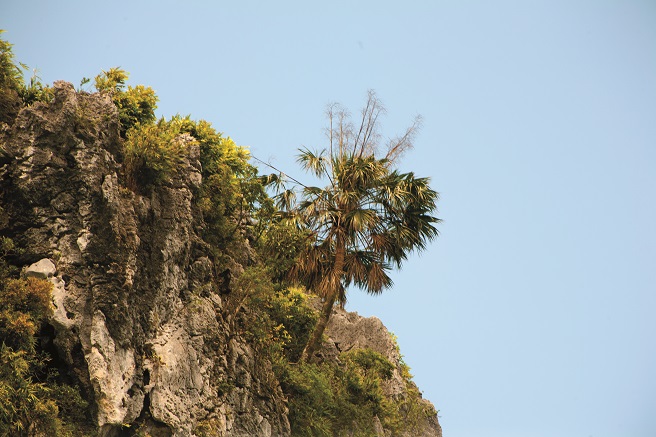 |
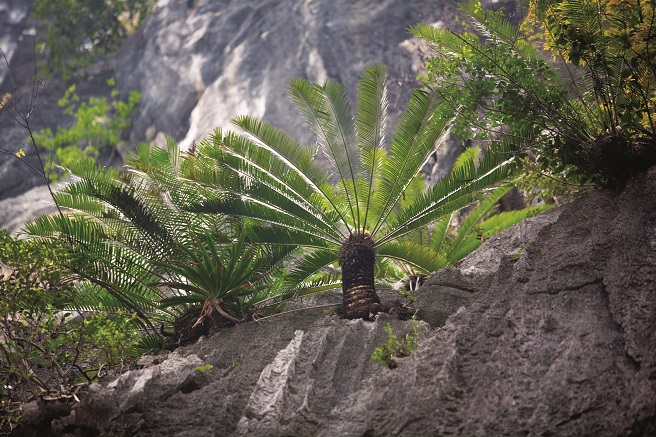 |
| (Chirita halongensis) | (Chirita hiepii) | (Chirita gemella) |
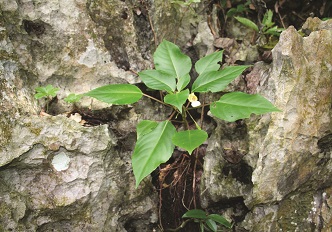 |
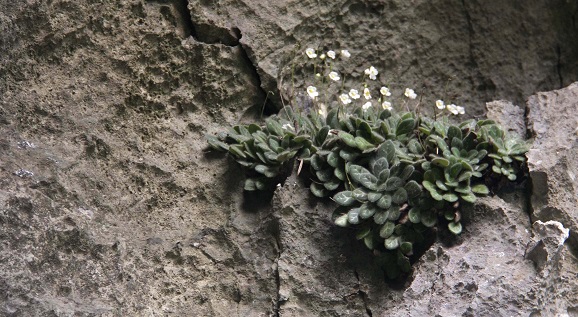 |
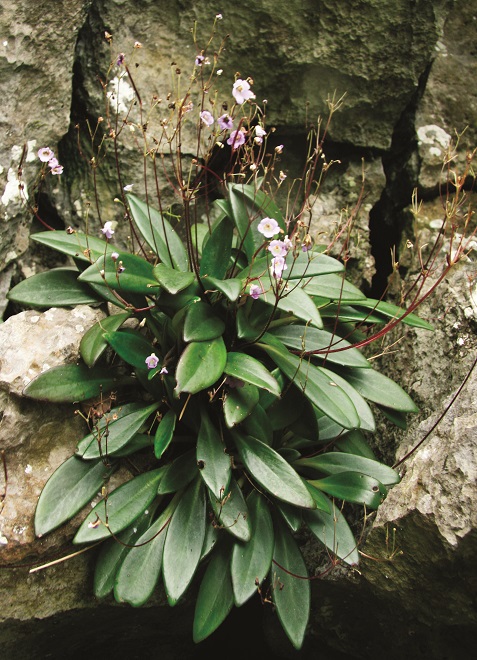 |
| (Chirita modesta) | (Impatiens halongensis) | (Paraboea halongensis) |
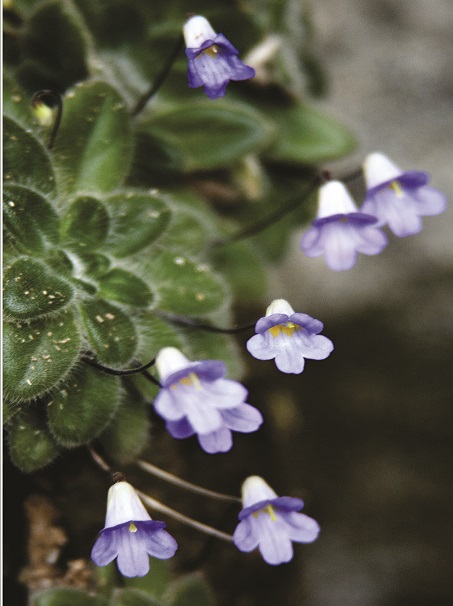 |
 |
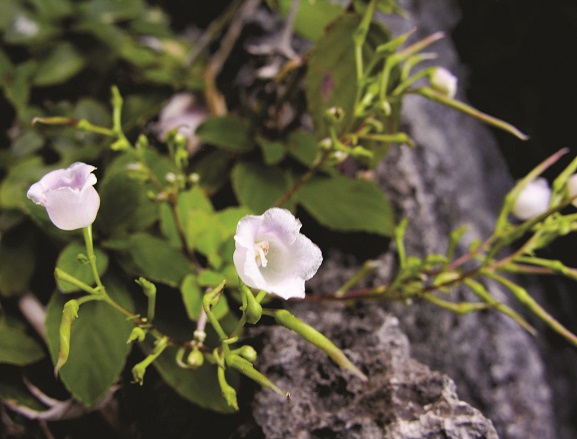 |
| (Livistona halongensis) | (Alpinia calcicola) | (Pilea alongensis) |
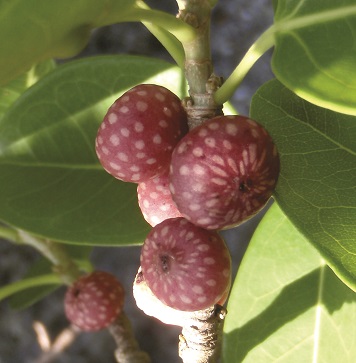 |
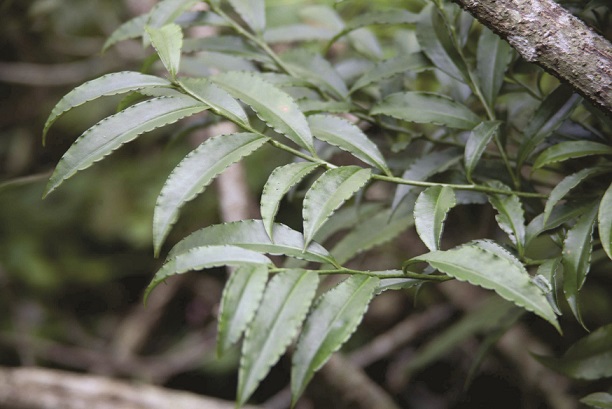 |
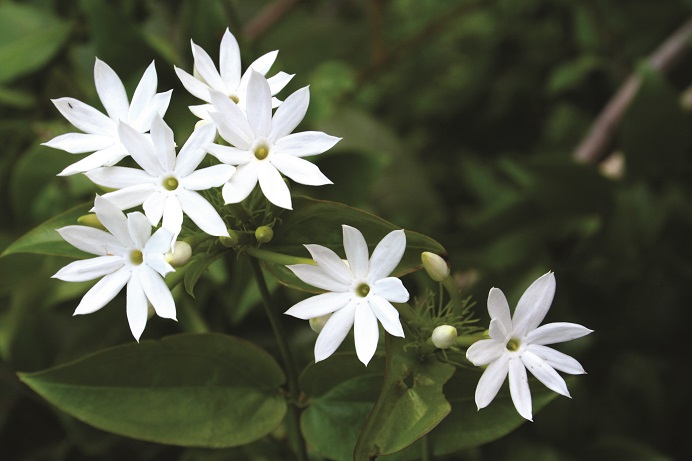 |
| (Cycas trophophylla) | (Neolitsea alongensis) | (Ardisia pedalis) |
 |
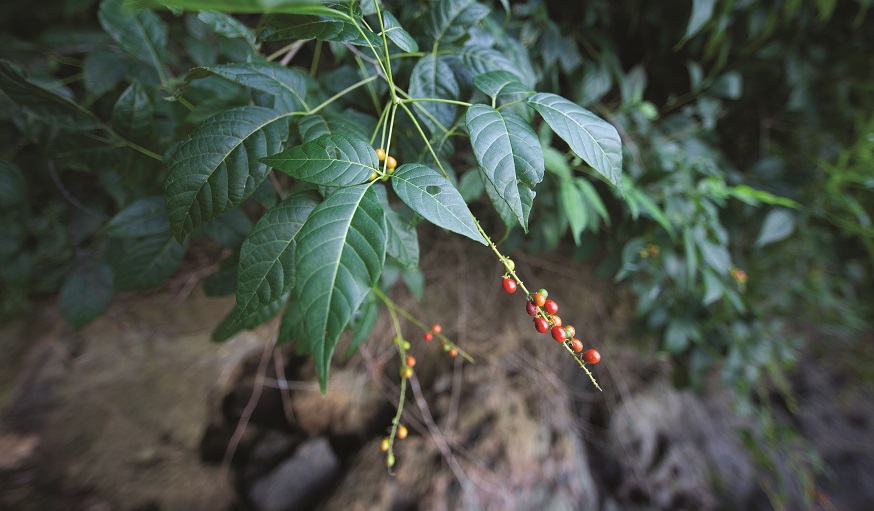 |
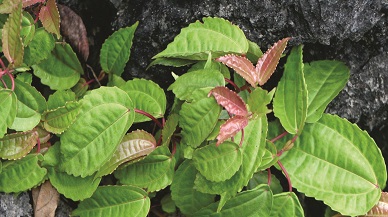 |
| (Hedyotis lecomtei) | (Allophylus leviscens) | (Jasminum alongensis) |
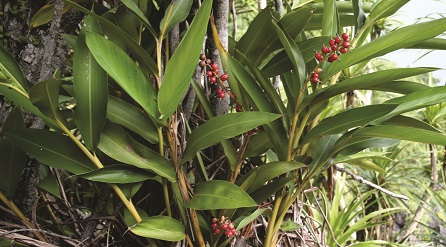 |
||
| (Schefflera alongensis) |
2) Tung – Ang Ecological System: This is a unique and typical ecosystem in the sea area with the presence of limestone islands, such as Ha Long Bay, Bai Tu Long bay, and Cat Ba. The Tung – Ang Ecological System is closed from the surroundings and surrounded by limestone islands which covered by green vegetation. Under water surface, there are lively and beautiful habitats with diverse marine creatures creating a nice, peaceful and different habitats, which is attractive and surprising. There are 21 species of seagrass, 37 species of mollusk, 8 species of crustacean, 6 species of echinoderm and some coral species. These species have lived in Tung – Ang Ecological System for a long time and become stably adapted to the habitat, so they have some different characteristics compered to others living outside.
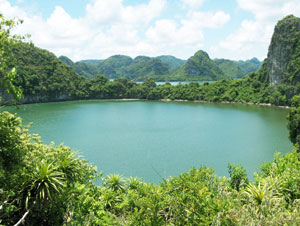
3) Cave Ecosystem: The cave ecosystem is also a typical ecosystem of sea area with the existence of limestone island. Cave habitats are offten dark, high humidity, poor natural food sources, and stable temperature. These lead to low porpulation of species inside the cave compared to other environment. However, most of species in the cave ecosystem in Ha Long Bayare endemic to the area. Thus, these species are valuable and important for researches on the evolution of organisms. Some species identified in Ha Long Bay’ cave, such as: Tiger Geokos (Goniurosaurus sp.), Ha Long cave crab, Ha Long cave loach, Alpheoid shrimps

4) Hard-bottomTidal Ecosystem: The hard-bottom tidal ecosystem (also known as tidal reef ecosystems around the islands) distributes around islands’ feet in Ha Long Bay. The hard bottom in this ecosystem include cliffs, sea norches, pebbles, rock 5-10m wide slid from the mountain. The habitat of this ecosystem is stable with many caves and holes resulting in the rich and diverse ecosystem, about 423 species including seaweed, coral, snail, bivalve, reptile, crustaceans …. However, because of small area of distribution, biological productivity of the ecosystem is not high. There are some notable species includingm Sarrgassum spp, snails, clams caught and sold at local markets only for daily meals.
5) Soft Bottom Tital Ecosystem: The soft bottom soft ecosystem is the low tidal flatland around the islands off the coast of Ha Long Bay. Based on the characteristics of the bottom, this ecosystem can be divided into two types: tidal flat sand powder, clay silt close mangrove forest and sand dunes rise outside the estuary. This ecosystem has a complex ecological environment that varies according to season, time in the day, and tide. Due to the complexity of this ecosystem, the number of species in the biomes is smaller compared to that in the offshore islands. The biome herecan be divided into two different groups: (1) The tidal flats settle groups including benthod, seaweeds, seagrasses, marine fish, (2) The group living with tide level include: phytoplankton, zooplankton, marine fish. In addition, some vertebrates also live there, look for food on the estuaries when the tide is low, such as water snakes, water birds…
6) Tidal Sandy Beach Ecosystem: Thisis a sandy tidal sandy beaches around small island,some sandy beaches withcoral reefs. Although the number of sandy beachis quite high, but their areas are small with quite steep slope. The components of beaches are sand, shells of bivalve (snails, oyster, clam), and dead coral. The beach is often exposed to the air at low tidelevel. Sandy beach ecosystem is poor in population compared to other marine ecosystem. Due to the unstable bottom, there is hardly zone distribution of creatures. Up to date, 116 species are recorded in the area, such as crab, sandcrab, polychaetes, bivalves, snails, crustaceans and echinoderms.
7) Mangrove Ecosystem: Mangroves are an important ecosystemandhome to many valuable marine species in the HaLong Bay area. There are 30 species of mangrove plants in Ha Long Bayand the surrounding area, counting for 32% of species of mangrove plantsin Vietnam. Among500 species living in the mangrove forest in Ha Long Bay, there are 03speciesof snail, three speciesof reptile, three species of bird and one species of mammal listed in the Red List of Vietnam. In mangrove forest, there are some valuable species, such as sea worm, octopus, clam, and crab etc…which are unique and special seafood locally.
8) Sea grass Ecosystem: This is an important marine ecosystem. Seagrass is nursery habitats of many shrimp, crabs and fish; Besides, seagrass ecosystems play an important role in protecting bottom and treating wastewater. According to some previous researches, the area of Ha Long Bay- Cat Ba has recorded five species of sea grass. However, the area of sea grass in Ha Long Bayhas been decreased rapidly due to land reclamation. Sea grass beds have been almost disappeared at coastal areas in Ha Long Bayarea, thus the value of the ecosystem is not promoted.
9) Regular Coastal Wetland Ecosystem: The coastal wetland ecosystem is a water surface of 0-20 m depth. This is quite a homogeneous water block, so this ecosystem consists of many different species such as phytoplankton, zooplankton, benthos, marine fish, reptiles, crustaceans, mollusks. Among which there are many economic value species, such as sea crab, shrimp, fish …
10) Coral Reef Ecosystem: Coral reefs in Ha Long Bayare composed mainly of hard coral species. In Ha Long Bay, corals concentrate in Cong Do, Tra San, Hang Trai, Dau Be (coverage from 30% – 45%). Coral reefs are habitat of economic value species, such as Geo-Duck, Cockle , grouper, pearl oyster, lobster … Besides, in coral reef ecosystem, there are many rare and endangered species listed in the Vietnam Red List such as Hydropuntia eucheumoides, seahorse, Japanese seahorse, black seahorse, Junceella gemmacea, Acropora florida , Tachypleus tridentatus, Tectus niloticus, Epitonium scalare, black pearl oyster, squid, Pharaoh cuttlefish….
Species Diversity
Ha Long Bayarea has variety of natural species distributing in 10 types of ecosystem, including terrestrial and aquatic, low-level and high-level species. Up to date, nearly 3,000 plant and animal species have been recorded in the area, including 507 species of terrestrial plants, 278 species of phytoplankton, 141 species of zooplankton, 110 species of coral, 156 species of fish, 71 species of birds, 53 species of mammals … This diversity demonstrates that Ha Long Bayarea is one of the most diversity area recorded in Vietnam.
Genetic diversity
Genetic diversity demonstrates the difference of Ha Long with other regions. Genetic system in Ha Long Bayincludes endemic, rare gene sources, medicinal or high economic value gene sources. Up to date, scientists have identified 102 endanger species at different levels (64 animal species and 38 plant species). Some species with low population are endemic to Ha Long, such as Ha Long cave loach, Ha Long cave crab, Alpheoid shrimp, Giant long-legged centipede… and 17 endemic plant species have been recorded. In addition, many genetic resources are a natural source of medicinal herbs. In Ha Long Bayarea, it is estimated that there are 357 species of plants and nearly 100 species of animals can be produced medicine. Some gene sources is valuable to produce exported sea food and handicraft, such as abalone, tectus niloticus, sweet snail, Strombidae, cockle, geo-duck, prawn, crabs, sea cucumbers, pearl oyster, grouper…
In conclusion, Ha Long Bay is diverse in types of ecosystems with characteristics of limestone islands in marine environment. The area’s diversity of ecosystems creates distinct habitats in the same geological zone for the development of variety of species with rare and endemic genetic sources. Those genetic sources are living sample for researching in the biological evolutional and developmental process of creatures with particular environmental condition in the area.

